coolant temperature DODGE DURANGO 2013 3.G User Guide
[x] Cancel search | Manufacturer: DODGE, Model Year: 2013, Model line: DURANGO, Model: DODGE DURANGO 2013 3.GPages: 140, PDF Size: 4.38 MB
Page 99 of 140

Vehicles Not Equipped With Keyless Enter-N-Go™
• Turn the ignition switch to the ON/RUN position (Do not start the engine.)
• Fully depress the accelerator pedal, slowly, three times within 10 seconds.
• Turn the ignition switch to the OFF/LOCK position.
NOTE:
If the indicator message illuminates when you start the vehicle, the oil change indicator
system did not reset. If necessary, repeat this procedure.
IF YOUR ENGINE OVERHEATS
• In any of the following situations, you can reduce the potential for overheating by takingthe appropriate action.
• On the highways — slow down.
• In city traffic — while stopped, place the transmission in NEUTRAL, but do not increase engine idle speed.
NOTE:
There are steps that you can take to slow down an impending overheat condition:
• If your air conditioner (A/C) is on, turn it off. The A/C system adds heat to the engine cooling system and turning the A/C off can help remove this heat.
• You can also turn the temperature control to maximum heat, the mode control to floor and the blower control to high. This allows the heater core to act as a supplement to the
radiator and aids in removing heat from the engine cooling system.
CAUTION!
Driving with a hot cooling system could damage your vehicle. If the temperature gauge
reads HOT (H), pull over and stop the vehicle. Idle the vehicle with the air conditioner turned
off until the pointer drops back into the normal range. If the pointer remains on HOT (H), and
you hear continuous chimes, turn the engine off immediately, and call for service.
WARNING!
You or others can be badly burned by hot engine coolant (antifreeze) or steam from your
radiator. If you see or hear steam coming from under the hood, do not open the hood until
the radiator has had time to cool. Never try to open a cooling system pressure cap when
the radiator or coolant bottle is hot.
WHAT TO DO IN EMERGENCIES
97
Page 122 of 140

MAINTENANCE SCHEDULE
Your vehicle is equipped with an automatic oil change indicator system. The oil change
indicator system will remind you that it is time to take your vehicle in for scheduled
maintenance.
Based on engine operation conditions, the oil change indicator message will illuminate. This
means that service is required for your vehicle. Operating conditions such as frequent short-
trips, trailer tow, extremely hot or cold ambient temperatures, and E85 fuel usage will influence
when the “Oil Change Required” message is displayed. Severe Operating Conditions can cause
the change oil message to illuminate as early as 3,500 miles (5 600 km) since last reset. Have
your vehicle serviced as soon as possible, within the next 500 miles (805 km).
Your authorized dealer will reset the oil change indicator message after completing the
scheduled oil change. If a scheduled oil change is performed by someone other than your
authorized dealer, the message can be reset by referring to the steps described under
“Electronic Vehicle Information Center (EVIC)/Oil Change Required” in “Understanding Your
Instrument Panel” for further information
NOTE:
Under no circumstances should oil change intervals exceed 10,000 miles (16 000 km) or
twelve months, whichever comes first.
Once A Month Or Before A Long Trip:
• Check engine oil level
• Check windshield washer fluid level
• Check the tire inflation pressures and look for unusual wear or damage
• Check the fluid levels of the coolant reservoir, brake master cylinder, power steering andtransmission as needed
• Check function of all interior and exterior lights
Required Maintenance
Refer to the Maintenance Schedules on the following pages for required maintenance.
At Every Oil Change Interval As Indicated By Oil Change Indicator System:
• Change oil and filter.
• Rotate the tires. Rotate at the first sign of irregular wear, even if it occurs before the oil
indicator system turns on.
• Inspect battery and clean and tighten terminals as required.
• Inspect automatic transmission fluid if equipped with dipstick.
• Inspect brake pads, shoes, rotors, drums, hoses and park brake.
• Inspect engine cooling system protection and hoses.
• Inspect exhaust system.
• Inspect engine air cleaner if using in dusty or off-road conditions.
MAINTAINING YOUR VEHICLE
120
Page 134 of 140

Adaptive Cruise Control (ACC)(Cruise Control) ............33
Airbag ...................17
Air Conditioning ..............37
AllWheelDrive(AWD)...........87
Anti-Lock Brake System (ABS) ......95
Arming Theft System (Security Alarm) . .16
Automatic Dimming Mirror ........31
Automatic Headlights ..........29
Automatic Temperature Control (ATC) . .37 SYNCTemperatureButton ......38
Automatic Transmission Fluid Type ..............118
AxleFluid................ .118
Back-UpCamera.............39
Battery Charging System Light ........95
Belts, Seat .................16
Blind Spot Monitoring ..........39
BrakeFluid............... .118
Brake System Warning Light ............94
Break-In Recommendations, New Vehicle ..............29
Bulb Replacement ............128
Calibration, Compass ...........81
Cargo Compartment Luggage Carrier ...........89
Change Oil Indicator ...........96
ChangingAFlatTire...........98
Charging System Light ..........95
Check Engine Light (Malfunction Indicator Light) ............94
Child Restraint ..............18
Child Restraint Tether Anchors ......18
Compass Calibration ...........81
Cooling System Coolant Capacity ..........118
Cruise Control (Speed Control) ......32
Cruise Light ................32
Customer Assistance ..........129
Defects, Reporting ............130
DimmerControl..............30 Dimmer Switch, Headlight
........30
Disarming, Theft System .........16
ECO....................81
Electronically Shifted Transfer Case . . .87
Electronic Range Select (ERS) ......36
Electronics Your Vehicle's Sound System ....42
Electronic Speed Control (Cruise Control) ............32
Electronic Stability Control (ESC) .....95
Electronic Throttle Control Warning Light .............95
Electronic Vehicle Information Center(EVIC)............80,81
Emergency, In Case of Jacking ................98
Overheating .............97
Emergency Key ..............10
Engine Break-In Recommendations .....29
Compartment ............116
Coolant
(Antifreeze) .........118
Malfunction Indicator
(Check Engine) ............94
Oil ..................118
Oil Filter ...............118
Oil Selection .............118
Overheating .............97
Starting ................15
Stopping ...............15
Event Data Recorder ...........113
Exterior Lights ..............128
Fluid Capacities .............118
Fluids.................. .118
FogLights ................29
Folding Front Passenger Seat ......22
Folding Power Third Row Head Restraints ...............25
Folding Rear Seat ...........23,25
Four Wheel Drive .............87
Operation ...............87
Systems ...............87
Four Wheel Drive Operation ........87
Freeing A Stuck Vehicle .........112
Front Heated Seats ............26
INDEX
132